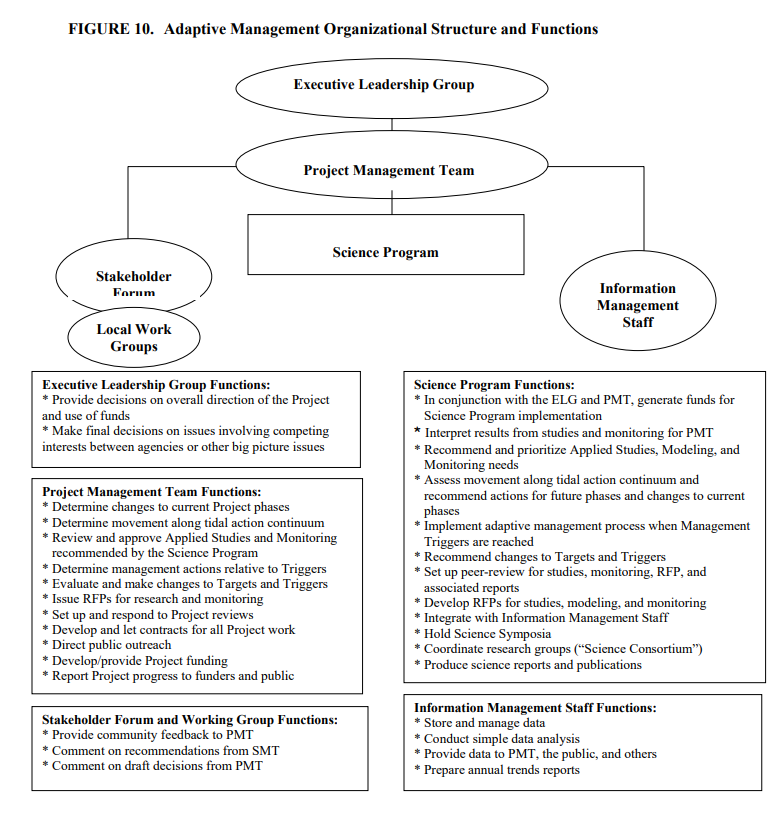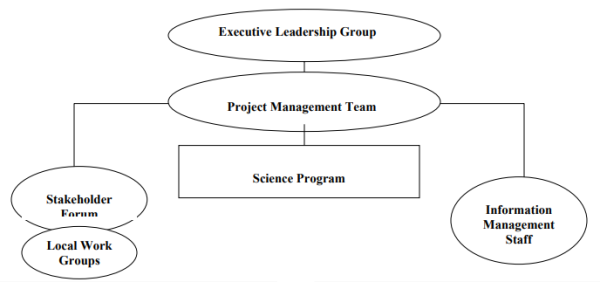PROGRAM STRUCTURE DURING IMPLEMENTATION:
Institutional Structure and Procedures
Organizational Structure
Adaptive management cannot be implemented without an effective decision-making structure that completes the loop between information development and the use of that information in decision-making. The institutional structure for decision-making described here is designed to achieve these four functions:
- Generate science-based information for managers (from monitoring and studies);
- Convert information into effective management decisions;
- Involve the public to help provide management direction; and
- Store and organize information for use by the decision-makers and the public.
Figure 10 shows the organizational structure that will be used to carry out these functions. This structure includes two primary elements, the Project Management Team (PMT), comprised of the USFWS, DFG, SCC, and other involved organizations, which is responsible for decision-making and taking action on those decisions, and the Science Program, comprised of science directors and contractors, which is responsible for data generation and interpretation. The science managers that direct the Science Program will be members of the PMT. Collectively, the PMT and the Science Program managers will evaluate: a) progress toward Project Objectives and restoration targets, b) monitoring and applied study priorities, c) corrections needed to current phases, and d) design of future phases. The PMT is ultimately responsible for all decisions that are implemented.
This structure evolved through a collaborative effort by the Project participants involved during the planning phase and is designed to allow a smooth transition from planning to implementation. The Project scientists and managers reviewed adaptive management programs in other ecosystem restoration projects (CERP, 2004, Flanigan, 2004; Glen Canyon Adaptive Management Plan, 2001) and found that every adaptive management program is structured differently to address the unique ecological and social features of the system. Society has not yet perfected the social, economic, and institutional components of adaptive management needed in specific contexts (Gunderson et al., 1995; Holling, 1978; Walters, 1997). However, one clear lesson from other ecosystem restoration projects is that institutional arrangements themselves need to be flexible and adaptive, as most attempts to institutionalize adaptive management into a standard template have failed (Walters, 1997). The structure and processes described here are expected to evolve over time to meet the Project’s needs.
Another lesson is that adaptive management cannot succeed unless participants in the decision-making structure communicate effectively with each other to share information and take action in a timely manner. When different groups or functions remain in “boxes” or “silos” separated from other parts of the structure, decision-making breaks down. Mechanisms to ensure communication include integration of the science managers into the PMT, regular meetings of the Stakeholders attended by PMT members, transparent peer-review procedures, and vehicles for providing information to all project participants and the public, including regular reports from the PMT and Science Program, newsletters, and a Project website.

Science Program
The Science Program will be directed by two science managers, the Lead Scientist and Monitoring Director, and will include an array of contractors hired to complete specific tasks. The Lead Scientist and Monitoring Director, supported by a Program assistant, will determine and manage the work to be done by the Program. They will be members of the PMT and will ensure long-term continuity in the Science Program. The contractors will be hired to conduct all work identified by the science managers, including collecting and analyzing monitoring data, conducting applied studies, writing reports that analyze and synthesize monitoring and applied studies information for use by the PMT, and conducting peer-reviews of science products and the Science Program itself.
The goal of the Science Program is to bring the best and most relevant science to decision-makers and the public in a timely fashion. The Science Program will provide the PMT with a scientific basis for adaptive management decisions on current and future Project actions as well as assisting with the development of restoration targets, and measuring Project success. The primary objectives of this Program are to develop priorities for applied studies and monitoring for the Project; to ensure that information from the Project’s applied studies and monitoring is synthesized, interpreted, and published in appropriate media for use by the PMT, other scientists, and the public; to develop, implement adaptive management processes; and to implement peerreview processes for Science Program projects and products as well as for the overall Project. The science managers will need to ensure that the best research organizations and qualified researchers are engaged in order for the Project to be successful.
The Lead Scientist is the overall science manager for the Science Program and will perform these functions:
- Generate local, national and international interest, and local and regional investment in the Science Program;
- Ensure Science Program efforts are credible, legitimate and relevant;
- Encourage the best scientists available to work on issues of interest to the Project;
- In concert with the ELG and PMT, identify and foster funding opportunities to support the Science Program.
Specific responsibilities of this position are to:
- Promote and build the visibility of the Science Program and the Project;
- Represent the Science Program to funders, academic institutions, at meetings, and other public venues;
- Seek funding and research opportunities to support the Science Program, including opportunities for formal partnerships with local Bay area academic institutions and researchers as well as opportunities through federal and state programs, e.g. Sea Grant and others
- As a member of the PMT, provide updates on Science Program activities and advise the PMT on all aspects of the Project connected to science, especially adaptive management decision making, changes needed in current Project phases, and design of future actions;
- Oversee the applied studies process, including the generation of syntheses of information and the production of peer-reviewed products/reports;
- Oversee adaptive management processes, such as when management triggers are tripped;
- Set up and oversee peer-review and expert panels/processes for Science Program products and the Program itself, as well as other aspects of the Project needing expert 3 input, such as refining restoration targets, adaptive management workshops, and Project reviews;
- Develop competitive proposal processes for applied studies and synthesis reports, and establish peer-review panels to evaluate study proposals and reports;
- Convene scientists and research institutions (“Science Consortium”) and encourage them to undertake research in the South Bay that cannot be funded by the Project;
- Hold Science Symposia, or other such venues, to highlight South Bay research;
- Attend Stakeholder Forum and Local Work Group meetings;
- Report on Science Program progress to the ELG and funders.
The Monitoring Director is responsible for developing and overseeing the operation of a system-wide monitoring program, including identifying monitoring parameters, developing monitoring protocols, and overseeing a competitive proposal process to hire consultants or research teams to collect the data. Specific responsibilities of this manager are to:
- Implement the process for identifying monitoring parameters and developing protocols;
- Ensure data are collected, analyzed, and published in useful peer-reviewed formats in a credible and timely fashion;
- Develop competitive proposal processes for monitoring work;
- Evaluate the monitoring data, as required (monthly to yearly), to determine progress toward restoration targets and management triggers;
- Ensure that those collecting data provide, on an established schedule, information and advice about data collection results and system conditions;
- Coordinate with the Information Management Staff on monitoring data storage, analysis, reporting, and presentation for the public and the Project Managers;
- Provide findings and recommendations to the PMT;
- Attend funder, stakeholder, and other meetings as needed;
- Help generate funds for the science program;
- Prioritize and recommend monitoring programs;
- Coordinate with other monitoring programs;
- Achieve a balance between time needed for contractor QA/QC and delivery of timely and accurate data.
These two science managers will work together in a cooperative effort to integrate their tasks. Together they will set the direction for the Science Program and assess whether the cumulative data collected are adequate to meet the Project’s needs. They will determine what products need to be produced by the Science Program and ensure that contractors provide those products. This oversight will require they review the quality of work produced by contractors. Joint tasks will also include assessing whether management triggers have been tripped; prioritizing research questions and monitoring needs; providing recommendations for adaptive management and Project implementation to the PMT; ensuring reports that interpret the results of studies and monitoring are prepared, peer reviewed, and published in appropriate formats for all audiences. Advising the PMT will require that the science managers synthesize the reports produced by the Science Program in a form usable by the PMT.
The Science Program will be supported by a Program Assistant who will be responsible for various administrative and research tasks. In particular, this assistant will help set up meetings, coordinate the peer-review process, and organize workshops, and symposia. Other 4 tasks will include helping the science managers establish contacts with researchers and consultants, assisting with RFP production and collecting information from other restoration and management projects to ensure that the Project has the most up-to-date and comprehensive information available. Other relevant projects, especially those around the Bay, must be included in the on-going information synthesis. Examples of such projects include the Napa Salt Ponds Restoration Project, CALFED Restoration Program, and the Hamilton Army Airfield Restoration.
The job of the science managers is to direct the work of the Science Program. The actual work--including collecting and analyzing monitoring data, undertaking applied studies, synthesizing the data generated, preparing peer-reviewed reports, and peer-review itself—will be conducted by contractors, especially research scientists and consultants. The contractors will be chosen on the basis of demonstrated skills and relevant experience through competitive proposal processes designed to bring the best scientists and experts to the Project for the specific tasks at hand (Appendix 4). The contractors associated with the Project at any one time will be determined by the particular work that needs to be done; a wide range of experts will contribute to the Project over time. On occasion, directed or sole-source contracts will be let (Appendix 4), but typically work will be subject to an open and fully competitive process.
The science managers are responsible for implementing peer review of the Science Program and its products. This process ensures that the work meets standards of scientific rigor. Most large restoration programs incorporate independent review panels, comprised of qualified individuals who are not participants in the long-term monitoring and research studies. These panels include peer reviewers and science advisors, and also protocol evaluation panels to assess the quality of research, monitoring, and science being conducted through the adaptive management program; they provide recommendations for further improvement. The entire Project, including the science and decision-making arms, will undergo review by experts external to the Project on a regular basis. For the first few years, the Project may be reviewed every other year. After that, 5-year reviews may be adequate.
In addition to peer review, monitoring and research will also require review and permitting by the landowners (DFG and FWS) and, in some cases, by regulatory agencies, such as the FWS Endangered Species Office. Work done through universities will require authorizations from human and animal care committees, when appropriate.




